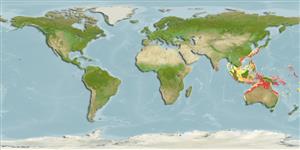Teleostei (teleosts) >
Carangiformes (Jacks) >
Carangidae (Jacks and pompanos) > Caranginae
Etymology: Alepes: Greek, alepis, -idos = without scales (Ref. 45335).
Environment: milieu / climate zone / depth range / distribution range
Ecology
Marine; demersal; depth range 5 - 80 m (Ref. 86942). Tropical
Western Central Pacific: endemic to northern Australia, from Exmouth Gulf, Western Australia to Wide Bay, Queensland.
Size / Weight / Age
Maturity: Lm ? range ? - ? cm
Max length : 29.5 cm TL male/unsexed; (Ref. 9894)
Dorsal spines (total): 8; Dorsal soft rays (total): 24 - 26; Anal spines: 3; Anal soft rays: 20 - 22; Vertebrae: 24. This species is distinguished by the following characters: adipose eyelid well developed on posterior half of the eye only; upper jaw narrowly rounded posteriorly, with supramaxilla relatively small without an anterior spine-like extension; gill rakers (including rudiments) 8-10 + 18-21 = 27-30. Colour in life green to bluish green above, silvery to white below, a diffuse dusky blotch on margin of opercle, not bordered above by a white spot; interradial membranes of spinous dorsal fin hyaline to dusky; spinous and second dorsal, anal, and caudal fins dusky yellow, with anterior rays of second dorsal and anal fins often with white tips; caudal-fin lobes often with dark tips; pelvic fins white and pectoral fins hyaline; juveniles with 7 dark bands on body (Ref. 9894).
Adults occur in inshore waters of the continental shelf (Ref. 75154). Feeds primarily on small invertebrates, primarily microscopic crustaceans and molluscs. Caught mainly on hook-and-line (Ref. 9894).
Life cycle and mating behavior
Maturities | Reproduction | Spawnings | Egg(s) | Fecundities | Larvae
Smith-Vaniz, W.F., 1999. Carangidae. Jacks and scads (also trevallies, queenfishes, runners, amberjacks, pilotfishes, pampanos, etc.). p. 2659-2756. In K.E. Carpenter and V.H. Niem (eds.) FAO species identification guide for fishery purposes. The living marine resources of the Western Central Pacific. Vol. 4. Bony fishes part 2 (Mugilidae to Carangidae). Rome, FAO. 2069-2790 p. (Ref. 9894)
IUCN Red List Status (Ref. 130435)
Threat to humans
Harmless
Human uses
Fisheries: commercial
Tools
Special reports
Download XML
Internet sources
Estimates based on models
Preferred temperature (Ref.
123201): 24.5 - 28.7, mean 27.7 °C (based on 544 cells).
Phylogenetic diversity index (Ref.
82804): PD
50 = 0.5312 [Uniqueness, from 0.5 = low to 2.0 = high].
Bayesian length-weight: a=0.01349 (0.00646 - 0.02815), b=2.96 (2.79 - 3.13), in cm total length, based on LWR estimates for this (Sub)family-body shape (Ref.
93245).
Trophic level (Ref.
69278): 3.5 ±0.5 se; based on size and trophs of closest relatives
Resilience (Ref.
120179): High, minimum population doubling time less than 15 months (Preliminary K or Fecundity.).
Fishing Vulnerability (Ref.
59153): Low vulnerability (20 of 100).
